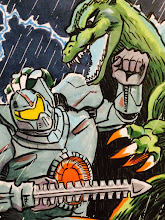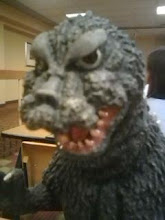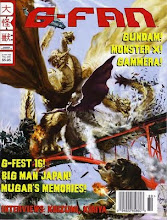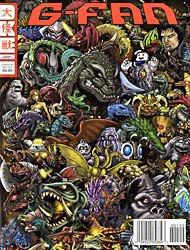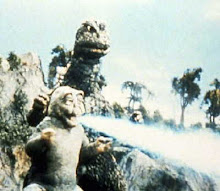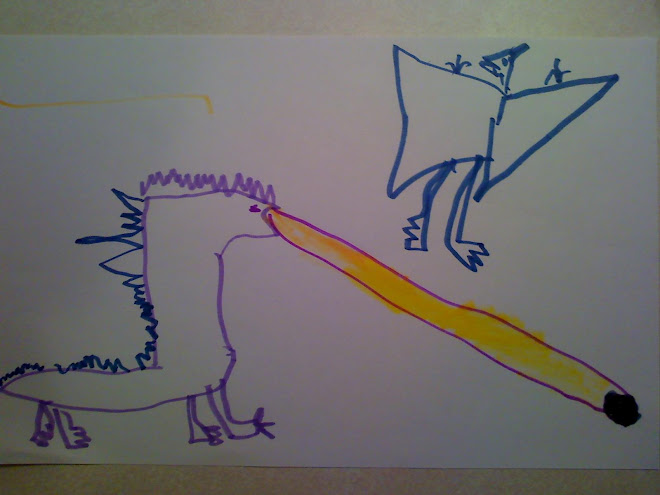
Monday, August 31, 2009
Mad Scientist Magazine #8 "Destroy All Monsters"

Sunday, August 30, 2009
Toybox Treasures: Ultraman Mebius & Friends/Foes
 Straight from the Space Garrison of Nebula M-78 comes Ultraman Mebius, whose feature film (Ultraman Mebius and the Ultraman Brothers) is required viewing for anyone who has an interest in the long, somewhat convoluted Ultra Saga. He poses here with three unidentified Ultra Foes; the most specific information I can give you is that the astounding mushroom-headed parrot monster you see on the far right actually appeared on Ultraman Cosmos. Each monster figure was made by Bandai in the mid-to-late 90's and early 00's and were available at G-Fest 16 for bargain prices. The Mebius figure, also located at G-Fest, is dated 2006.
Straight from the Space Garrison of Nebula M-78 comes Ultraman Mebius, whose feature film (Ultraman Mebius and the Ultraman Brothers) is required viewing for anyone who has an interest in the long, somewhat convoluted Ultra Saga. He poses here with three unidentified Ultra Foes; the most specific information I can give you is that the astounding mushroom-headed parrot monster you see on the far right actually appeared on Ultraman Cosmos. Each monster figure was made by Bandai in the mid-to-late 90's and early 00's and were available at G-Fest 16 for bargain prices. The Mebius figure, also located at G-Fest, is dated 2006.Saturday, August 29, 2009
Now Playing: Gamera vs. Guiron (MST3K edition)

Thursday, August 27, 2009
Now Playing: Ultra-Nostalgia

Part of what makes Ultraman Max such a fun series to watch is its deliberate connection to the Ultra-series of the past, including the original. Susumu Korobe, who played Hayata in that first series, (and who is shown here with his daughter Takami Yoshimoto, who starred as Rena in the magnificent Ultraman Tiga series) has a recurring role as Chief Tomioka, and his character takes center stage in Episode 23 of Ultraman Max, "The Return of Youth." Hiroko Sakurai--Fuji from the orginal series--is featured throughout Max as Professor Yoshinaga. However, what adds a charge to this episode is the appearance of Masanari Nihei, who provided much of the Science Patrol's comic relief as Ito in the first Ultraman series. In Max, he is a UDF scientist and inventor whose submarine/airplane eventually subdues the mutant flying fish Flaigular. His jovial prescence and comedic timing are still very much intact (as my son succintly put it, "he's still funny,") and it is just a hoot to see "Hayata, Fuji, and Ito" together again onscreen (although their backstory in Max is somewhat different--they refer to their shared past as "fighter pilots"). There is a great scene in which Chief Tomioka (Korobe) resolves to pilot the submarine/airplane and do battle against Flaigular, and you just know that "Hayata" is going back into action. Tsuburaya Productions does a wise thing in honoring and celebrating its own past, and in this episode they really give a valentine to Ultra-fans.
Wednesday, August 26, 2009
Just Arrived: Icons of Sci-Fi: The Toho Collection and Space Amoeba
Tuesday, August 25, 2009
The Definitive Word on Ultra Q
 The other day I was surfing the 'net and I ended up at the official Tsuburaya Productions Website. I was pleased to discover that they have an English page; not quite as pleased (but still amused) to find it reported the air times of Ultraman programs being shown around the world...and that's about it. However, they did have a "contact us" e-mail address...so this is what I wrote...
The other day I was surfing the 'net and I ended up at the official Tsuburaya Productions Website. I was pleased to discover that they have an English page; not quite as pleased (but still amused) to find it reported the air times of Ultraman programs being shown around the world...and that's about it. However, they did have a "contact us" e-mail address...so this is what I wrote...Greetings! My son and I love Ultraman! This summer we had the privilege of meeting Mr. Kenji Sahara at G-Fest 16 in Chicago. Could you tell me if Ultra Q will ever be released on DVD in the United States? If it is, I promise to buy
it! Thank you.
Well, I figured that was it--I had sent my little missive out, and that would be the end of it. So imagine my surprise when I checked my e-mail and saw:
From: TSUBURAYA PRODUCTIONS
Hi Mark,
Thank you for your inquiry.
Unfortunately, we do not have any plans of releasing Ultra Q in the United States.
Best Regards,
International Business Affairs
TSUBURAYA PRODUCTIONS CO., LTD.
So there you have it: the definitive word on an American release of Ultra Q--the word is "no." Nuts.
But I must admit it was pretty cool to see TSUBURAYA PRODUCTIONS in my Inbox!
Monday, August 24, 2009
G-FAN Magazine #69 "Half Human; All Good"
 The best issues of G-FAN strike a balance between film analysis, topical, well-researched articles, reporting on actual events and film releases, fan fiction, art, and reaction (via letters), reviews, collectible showcases, model-making intructionals, and more that I am probably forgetting. Issue 69 gets that balance exceptionally right.
The best issues of G-FAN strike a balance between film analysis, topical, well-researched articles, reporting on actual events and film releases, fan fiction, art, and reaction (via letters), reviews, collectible showcases, model-making intructionals, and more that I am probably forgetting. Issue 69 gets that balance exceptionally right.One of the first thing that grabs the reader's attention is the monster concept art for Godzilla: Final Wars. With the advantage of hindsight, one can see that the concepts and the finished products were remarkably close.
Tom Tvrdik begins a four-part series describing the process of creating the first American Greetings/Carlton Godzilla ornament.
Armand Vaquer's account of the G-Tour of Japan was awe-inspiring. Any one day of G-Tour would have held the thrill of a lifetime for G-fans. Could there be a G-Tour 2?
"A Monster for All Seasons" by David Annandale does as good a job as I've seen of analyzing the symbolic value of Godzilla, which successfully explains the negative reaction to Zilla/GINO.
The centerpiece of the issue is Peter H. Brothers' "Abominable Snowman/Half Human" article. It is an exhaustive, definitive treatment of a truly hidden classic, and is accompanied by production stills as well as stills from the film itself.
Brett Homenick interviews Loren Coleman, with respect to his stated appreciation of "Half Human." In fact, Mr. Coleman credits "Half Human" with sparking his interest in cryptozoology, which he has since introduced into popular culture with more gusto than any other author or researcher. This is a special article for me, because I have been a Loren Coleman fan ever since picking up a copy of Mysterious America in the late 1980s and learning that we are both from Decatur, Illinois.
"Battles of G-Fantis" is dynamic and imaginative, Steve Agin ushers us through his hall of toy treats, and David McRobie's "The Globe Meter" is a whirlwind trip around the world of kaiju-related viewing.
And there is even more intriguing reading to be found in issue 69, such as a spotlight on Chibi Goji Toys, a heavily illustrated wrap-up of G-Fest XI, a Gorgo article by the always-cogent Allen A. Debus, artistic work by Joylon Yates and a rebuttal to Roger Ebert's dismissive review of Gojira (Godzilla 1954) by M.G. Keller.
G-FAN 69 is J.D. Lees and friends "firing on all cylinders" to deliver intellegent, horizon-expanding coverage of the Godzilla phenomenon in all its permutations. There is no filler whatsoever in this great 82-pager, and it would serve as an excellent introduction to G-FAN for the uninitiated.
Want more Loren Coleman info? Visit http://cryptomundo.com for breaking news and analysis of our weird world and the hidden creatures that inhabit it!
Sunday, August 23, 2009
Toybox Treasure: Godzilla Raids Again

Saturday, August 22, 2009
Toybox Treasure: It's Jiras!

Did you know that Ultraman duked it out with Godzilla on Japanese T.V. in 1966? It's true! Well, kinda...
What actually happened for the tenth episode of Ultraman is that Tsuburaya Productions took the Godzilla suit from Godzilla vs. the Thing/Mothra vs. Godzilla and attached it to the Godzilla head from Monster Zero/Invasion of Astro Monster, put a big dino frill around his neck and called him Jiras! Jiras gets a few licks in, but ultimately suffers a (bloody (!)) defeat at the hands of Ultraman.
This particular Jiras was made by Bandai in 1995. I found it on ebay after searching for a Jiras at G-Fest and coming up empty-handed. He just arrived in the mail today! By the way, Godzilla would return to the small screen in another show called Zone Fighter, produced by Toho. This meant that other Toho monsters would make appearances on Zone Fighter, such as King Ghidorah and Gigan. Their inclusion is a commentary on how television "changed the game" forever for giant monster movies. Whether it changed the game for good is another story. Anyway, enjoy Jiras--a unique sidebar to Godzilla's biography!
Friday, August 21, 2009
Now Playing: Godzilla vs. Biollante

 Mei Ah Laser Disc, a Hong Kong based company, it includes Monster of Monsters, Ghidorah; Destroy All Monsters; Godzilla vs. Gigan; Return of Godzilla; and Godzilla vs. King Ghidorah; as well as two super-deformed Godzilla figures. What a find!
Mei Ah Laser Disc, a Hong Kong based company, it includes Monster of Monsters, Ghidorah; Destroy All Monsters; Godzilla vs. Gigan; Return of Godzilla; and Godzilla vs. King Ghidorah; as well as two super-deformed Godzilla figures. What a find!Wednesday, August 19, 2009
Toybox Treasures: Big Bandai Bash
 These big guys (Kiryu/Mechagodzilla stands 12" tall, Godzilla 11") were widely available at toy stores throughout the U.S. These fellows were acquired at our local Toys R Us. The Kiryu figure in particular is very detailed and true to the movie design. The Godzilla figure most closely resembles the suit from Final Wars, although it is not an exact replica. Affordable and attention grabbing, one can only hope that Bandai America continues to release figures of this quality. Let the battle begin!
These big guys (Kiryu/Mechagodzilla stands 12" tall, Godzilla 11") were widely available at toy stores throughout the U.S. These fellows were acquired at our local Toys R Us. The Kiryu figure in particular is very detailed and true to the movie design. The Godzilla figure most closely resembles the suit from Final Wars, although it is not an exact replica. Affordable and attention grabbing, one can only hope that Bandai America continues to release figures of this quality. Let the battle begin! Now Playing: Ultraman Tiga's "The Ultra Star"

Monday, August 17, 2009
Kaiju Book Review: "Classic Movie Monsters"

Sunday, August 16, 2009
Toybox Treasures: Mecha King Ghidorah Puzzle

Friday, August 14, 2009
G-FAN Magazine # 41 "Millenial Magnum Opus"

Wednesday, August 12, 2009
Now Playing: Godzilla vs. Gigan
 The 1970s mean many things to many people. To Godzilla fans, the 70s are the era of polarization; one camp is downright resentful that the Big G became kiddie fare, and the other camp--the camp that constituted the targeted kiddies--has a special appreciation for the 70s flicks. I can do no other than freely admit that I fall into the latter camp, to the degree that as one of those kiddies I saw these movies in the theater with my dad and loved them.
The 1970s mean many things to many people. To Godzilla fans, the 70s are the era of polarization; one camp is downright resentful that the Big G became kiddie fare, and the other camp--the camp that constituted the targeted kiddies--has a special appreciation for the 70s flicks. I can do no other than freely admit that I fall into the latter camp, to the degree that as one of those kiddies I saw these movies in the theater with my dad and loved them.Monday, August 10, 2009
G-Fest Day Four: The Best for Last
 ou had me at "hello") of "The Manster," an unnerving, genre-blending thriller. Good stuff! We headed downstairs to visit the Dealer's Room one more time, but on the way we discovered that Kenji Sahara was signing more autographs. (He was only scheduled to sign on Saturday.) After a twenty minute wait, we had our small audience with Mr. Sahara. With nothing in hand, we asked him to sign the back of our G-Fest badges. We also posed for a quick photo with him--a moment of special excellence, because it had happened so spontaneously.
ou had me at "hello") of "The Manster," an unnerving, genre-blending thriller. Good stuff! We headed downstairs to visit the Dealer's Room one more time, but on the way we discovered that Kenji Sahara was signing more autographs. (He was only scheduled to sign on Saturday.) After a twenty minute wait, we had our small audience with Mr. Sahara. With nothing in hand, we asked him to sign the back of our G-Fest badges. We also posed for a quick photo with him--a moment of special excellence, because it had happened so spontaneously. It also led right into our next activity--August Ragone's interview of Mr. Sahara with the focus on Ultra Q. It was for panels like this that I had come to G-Fest, and Mr. Sahara and Mr. Ragone provided an engrossing hour of information and recollection. The clips of the original Ultra Q were exciting and Mr. Sahara was eager to speak about his experiences in this groundbreaking series. Mr. Sahara even hinted that an Ultra Q anniversary release might be a possibility. (Could you imagine an Ultra Q series box set?) It was heartwarming to hear how Ultra Q made Mr. Sahara an instantly beloved figure among children in Japan. The panel concluded with a well-deserved standing ovation for a true living legend.
It also led right into our next activity--August Ragone's interview of Mr. Sahara with the focus on Ultra Q. It was for panels like this that I had come to G-Fest, and Mr. Sahara and Mr. Ragone provided an engrossing hour of information and recollection. The clips of the original Ultra Q were exciting and Mr. Sahara was eager to speak about his experiences in this groundbreaking series. Mr. Sahara even hinted that an Ultra Q anniversary release might be a possibility. (Could you imagine an Ultra Q series box set?) It was heartwarming to hear how Ultra Q made Mr. Sahara an instantly beloved figure among children in Japan. The panel concluded with a well-deserved standing ovation for a true living legend.Sunday, August 9, 2009
Toybox Treasures: Bandai Baltans
 Baltan has been making the Science Patrol's life miserable ever since the second episode of the original series. Simple in design, yet threateningly impersonal and alien, Baltan is the perfect fighting foil for Ultraman, possessing both humanoid qualities and special powers. This Bandai set, acquired at G-Fest 16, shows the variations in Baltan suits down through the years, including the "Baby Baltan" that appears in the Ultraman Cosmos films. Whenever you're in the mood for a little world domination (and, come on--when aren't you?) the Baltan family is ready to lend a lobster claw appendage!
Baltan has been making the Science Patrol's life miserable ever since the second episode of the original series. Simple in design, yet threateningly impersonal and alien, Baltan is the perfect fighting foil for Ultraman, possessing both humanoid qualities and special powers. This Bandai set, acquired at G-Fest 16, shows the variations in Baltan suits down through the years, including the "Baby Baltan" that appears in the Ultraman Cosmos films. Whenever you're in the mood for a little world domination (and, come on--when aren't you?) the Baltan family is ready to lend a lobster claw appendage!Saturday, August 8, 2009
Kaiju (Books) Sighted in Cleveland!
 Located in the heart of downtown Cleveland, Ohio, the Cleveland Public Library boasts a staggering collection of every type of media. We decided to search for monster movie-related material, with an eye for Godzilla and friends. We were not disappointed. Once we found the appropriate section (...not used to Library of Congress catalogue...more of a Dewey system guy...) our choices were many, especially in terms of all monster/horror/scifi cinema. But here's what we found specifically: The CPL carries three copies of David Kalat's "A Critical Filmography...", two copies each of Steve Ryfle's "Japan's Biggest Mon-star" and William Tsutsui's "Godzilla on My Mind", and single copies of
Located in the heart of downtown Cleveland, Ohio, the Cleveland Public Library boasts a staggering collection of every type of media. We decided to search for monster movie-related material, with an eye for Godzilla and friends. We were not disappointed. Once we found the appropriate section (...not used to Library of Congress catalogue...more of a Dewey system guy...) our choices were many, especially in terms of all monster/horror/scifi cinema. But here's what we found specifically: The CPL carries three copies of David Kalat's "A Critical Filmography...", two copies each of Steve Ryfle's "Japan's Biggest Mon-star" and William Tsutsui's "Godzilla on My Mind", and single copies of  William Schoell's "Creature Features" (a big disappointment--in the dedication he calls Ghidrah the Three-Headed Monster both "awful" and "atrocious"(!)), a quirky self-published tome called "Giant Monster Movies" by Robert Marrero, and, the "find" of the day, Donald Glut's "Classic Movie Monsters," with excellent chapters on King Kong and Godzilla. The CPL is a great destination for kaiju readers! What's at your library?
William Schoell's "Creature Features" (a big disappointment--in the dedication he calls Ghidrah the Three-Headed Monster both "awful" and "atrocious"(!)), a quirky self-published tome called "Giant Monster Movies" by Robert Marrero, and, the "find" of the day, Donald Glut's "Classic Movie Monsters," with excellent chapters on King Kong and Godzilla. The CPL is a great destination for kaiju readers! What's at your library?
Wednesday, August 5, 2009
G-Fest Day Three: Kaiju on Parade
 We assembled at 7:00 p.m. for two events that get at the heart of G-fandom: the G-Pardy final and the Costume Parade. G-Pardy is literally Godzilla Jeopardy, with J.D. Lees in the Alex Trebek role, and the arcane knowledge evidenced here was jaw-dropping. Among my peers I am considered a Godzilla "expert"--yet I freely admit that it would take months of intense study for me to even come close to being competitive with the likes of these contestants (one of whom, Skip Peel by name, is responsible for the bulk of the fan fiction that has appeared in G-Fan). Sue, Andy and I were all captivated by this impressive showing.
We assembled at 7:00 p.m. for two events that get at the heart of G-fandom: the G-Pardy final and the Costume Parade. G-Pardy is literally Godzilla Jeopardy, with J.D. Lees in the Alex Trebek role, and the arcane knowledge evidenced here was jaw-dropping. Among my peers I am considered a Godzilla "expert"--yet I freely admit that it would take months of intense study for me to even come close to being competitive with the likes of these contestants (one of whom, Skip Peel by name, is responsible for the bulk of the fan fiction that has appeared in G-Fan). Sue, Andy and I were all captivated by this impressive showing. The most raucous cheers were reserved for Sanda and Gaila from War of the Gargantuas. We all wanted to see them rumble, and they happily obliged. One can only imagine how much time and effort went into the preparation of these costumes--the Costume Session ballroom display helps the layman gain a better appreciation of the craftsmanship involved (and also serves as a museum of absolutely incredible entries from past parades).
The most raucous cheers were reserved for Sanda and Gaila from War of the Gargantuas. We all wanted to see them rumble, and they happily obliged. One can only imagine how much time and effort went into the preparation of these costumes--the Costume Session ballroom display helps the layman gain a better appreciation of the craftsmanship involved (and also serves as a museum of absolutely incredible entries from past parades). One more significant decision was made--to stay home from the Pickwick, for reasons having to do with a severely sleep-deprived six-year-old. Thanks to Channel 19 (ah, Channel 19) this was a fairly easy conclusion to reach. I had great intentions of staying up to watch Gamera 3: Revenge of Iyrs (which I have yet to see), but a day of monster chasing caught up with me. I cannot confirm this, but I believe I fell asleep with a big, toothy, Gamera grin on my face.
One more significant decision was made--to stay home from the Pickwick, for reasons having to do with a severely sleep-deprived six-year-old. Thanks to Channel 19 (ah, Channel 19) this was a fairly easy conclusion to reach. I had great intentions of staying up to watch Gamera 3: Revenge of Iyrs (which I have yet to see), but a day of monster chasing caught up with me. I cannot confirm this, but I believe I fell asleep with a big, toothy, Gamera grin on my face.G-Fan Magazine # 36 "Monsters & MST3K"
 Issue 36 is a time capsule of sorts: the G-Mail section is heavy on Deanzilla (pro and con); new VHS releases are being touted; and there is an entire article devoted to Mystery Science Theater 3000. I have very happy memories of watching MST3K with my dad during the show's heyday (it was "appointment viewing" for us before the phrase was coined) and the enjoyment was multiplied whenever the Satellite of Love received an honest-to-goodness monster movie. (Whether or not a film like Godzilla vs. the Sea Monster qualifies as "cheesy" is a matter of valid debate--and it also falls outside the scope of this review.) I always felt the MSTies took an affectionate (rather than a derisive) approach to the movies it roasted, and the article herein seemed to support my point of view. I mean, if the Gamera song that Joel and the 'bots come up with doesn't make you at least chuckle, you and I probably wouldn't get along very well. Also included in Issue 36 is a "you are there" report from the set of Gamera 3 and a thorough analysis of the "Powers of Godzilla" by G-Fan editor and publisher J.D. Lees. Of great interest to the literary-minded: the letters section features an in-depth description of the origin and writing process of Random House's "Official Godzilla Compendium." The abundance of fan art, as well as two well-reasoned CD reviews, help make this an issue that encourages repeat reading.
Issue 36 is a time capsule of sorts: the G-Mail section is heavy on Deanzilla (pro and con); new VHS releases are being touted; and there is an entire article devoted to Mystery Science Theater 3000. I have very happy memories of watching MST3K with my dad during the show's heyday (it was "appointment viewing" for us before the phrase was coined) and the enjoyment was multiplied whenever the Satellite of Love received an honest-to-goodness monster movie. (Whether or not a film like Godzilla vs. the Sea Monster qualifies as "cheesy" is a matter of valid debate--and it also falls outside the scope of this review.) I always felt the MSTies took an affectionate (rather than a derisive) approach to the movies it roasted, and the article herein seemed to support my point of view. I mean, if the Gamera song that Joel and the 'bots come up with doesn't make you at least chuckle, you and I probably wouldn't get along very well. Also included in Issue 36 is a "you are there" report from the set of Gamera 3 and a thorough analysis of the "Powers of Godzilla" by G-Fan editor and publisher J.D. Lees. Of great interest to the literary-minded: the letters section features an in-depth description of the origin and writing process of Random House's "Official Godzilla Compendium." The abundance of fan art, as well as two well-reasoned CD reviews, help make this an issue that encourages repeat reading.Monday, August 3, 2009
G-Fest Day Three: Decisions, Decisions
 Saturday began with our first exposure to Space Giants on good old channel 19. (By now I was beginning to grow very attached to this station!) But an important value decision was looming: Hit the Dealer's Room, or take in Kenji Sahara's interview? Banking on the scheduled Sunday panel in which August Ragone was set to interview Mr. Sahara regarding Ultra Q, the decision was made to spend as much time as we needed in the Toys R Us of our dreams, and made our way downstairs.
Saturday began with our first exposure to Space Giants on good old channel 19. (By now I was beginning to grow very attached to this station!) But an important value decision was looming: Hit the Dealer's Room, or take in Kenji Sahara's interview? Banking on the scheduled Sunday panel in which August Ragone was set to interview Mr. Sahara regarding Ultra Q, the decision was made to spend as much time as we needed in the Toys R Us of our dreams, and made our way downstairs.As we waited in the relatively short line, costumed Godzilla and Kamacurus strolled by, and Gojigirl Linda Conrad passed out inflatable paper beach balls to the shoppers--a nice gesture! In no time, we were back inside the hallowed halls of the Dealer's Room.
It soon became evident that we had chosen wisely. The pace was slow; there was plenty of elbow room; we were able to take our time at each booth and wonder at the rare collectibles before our eyes. All the dealers were pleasant and there were plenty of affordable treasures to be had. Another momentous decision was made--I purchased a set of raffle tickets at the Kaiju Modeler table (more about that later).
 After a cafe lunch (with Gamera vs. Barugon playing on the TV over my shoulder--how cool is that (?)) Andy and I headed to Ballroom 3 for a panel on "Japanese Superheroes." The presenters had done their homework and it showed in an information-packed, fast-paced hour--especially appreciated were the slides that depicted each Ultra series. Lenell Bridges' enthusiasm for the subject matter didn't hurt, either. The insider info on series like Starman, Inframan, Kamen Rider and Zone Fighter were fascinating. I would have gladly stayed put for another hour or two.
After a cafe lunch (with Gamera vs. Barugon playing on the TV over my shoulder--how cool is that (?)) Andy and I headed to Ballroom 3 for a panel on "Japanese Superheroes." The presenters had done their homework and it showed in an information-packed, fast-paced hour--especially appreciated were the slides that depicted each Ultra series. Lenell Bridges' enthusiasm for the subject matter didn't hurt, either. The insider info on series like Starman, Inframan, Kamen Rider and Zone Fighter were fascinating. I would have gladly stayed put for another hour or two.By now the model display had opened, so we headed downstairs to observe the handiwork. I knew the model "thread" was its own arm of G-Fest and kaiju fandom--a creative subculture, if you will--but I was unprepared for the level of artistry we encountered. The photos you see here are no substitute for the real deal. Most breathtaking was a diorama of the complete kaiju cast of Destroy All Monsters. It was enough to make one consider a new hobby. Hmmm.
After some more spirited fun in Minya's Place (again, I would like to acknowledge the outstanding work of Ron Lipecky--your drawings and crafts are collectibles in their own right) I ducked into the back of the "Underrated Kaiju Classics" panel. This was a Dream Team of commentators, each of whom were informed and immersed in the subject at hand. However, I was a bit surprised when one presenter came on pretty strong, excoriating those present who had never seen a non-Godzilla kaiju film. I understood his point, which was basically "broaden your horizons, people" but a less abrasive, more persuasive approach may have been all that was necessary. Then again, he knows his audience better than I do. The bottom line is that his point was irrefutable: see as many tokasatsu films as possible! I'm on board with that!
G-Fan Magazine # 77: "Ultra Cool"
 It has been pretty Ultracentric around these parts lately--so what better time to review G-Fan #77, which includes 20 pages of coverage of "our hero, Ultraman"?
It has been pretty Ultracentric around these parts lately--so what better time to review G-Fan #77, which includes 20 pages of coverage of "our hero, Ultraman"?Issue 77 starts strong with an incredibly detailed (almost play-by-play) account of the making of Godzilla-Tokyo S.O.S.
Brett Homenick clocks in with four interviews of dubbing/voiceover actors and the results are of great interest to anyone who has ever wondered about that infamous process.
The centerpiece of the issue is the Ultraman 40th anniversary section, with a comprehensive and intelligent consideration of "new school" Ultra series by Robert Hood. Supplementing his article is a treasure trove of photos that help put a name with an Ultra-face.
The recap of G-Fest 13 was enjoyable (moreso now that we've been to one) and the G-Fantis comic is one of my son's favorites. I would be remiss if I did not mention Steve Agin's pulse-pounding collectibles column, illustrated in glorious full color, and another one of Armand Vacquer's insightful "kaiju geography" pieces.
G-Fan #77 is not just a great issue, but for my son and me it has become a valuable reference tool in our ongoing quest for Ultra-fun.
Now Playing: Ultra-Movie Marathon

 Next was Ultraman Tiga: the Final Odyssey, which picks up where the television series left off. It is great to see the cast of Tiga reunited--the GUTS team always had a special chemistry. We learn in The Final Odyssey that Tiga was once a malevolent titan that chose good over evil, infuriating his companions. Other highlights include the introduction of villainess Ultrawoman Kamila and the Christian marriage (!) of Daigo and Rena. True Tiga nuts will dig the extended version of "Take Me Higher" that plays while the closing credits roll.
Next was Ultraman Tiga: the Final Odyssey, which picks up where the television series left off. It is great to see the cast of Tiga reunited--the GUTS team always had a special chemistry. We learn in The Final Odyssey that Tiga was once a malevolent titan that chose good over evil, infuriating his companions. Other highlights include the introduction of villainess Ultrawoman Kamila and the Christian marriage (!) of Daigo and Rena. True Tiga nuts will dig the extended version of "Take Me Higher" that plays while the closing credits roll. Sunday, August 2, 2009
G-Fest Day Two: Back to the Pickwick
 Sue came with us to the Friday night screening of The Mysterians. I am learning just how much these movies were made to be seen on a real movie screen--and The Mysterians is a good case in point. It was introduced by its star, Mr. Kenji Sahara, who revealed that he and co-star Akhiko Hirata, in friendly rivalry, pushed each other to do their best in their respective roles.
Sue came with us to the Friday night screening of The Mysterians. I am learning just how much these movies were made to be seen on a real movie screen--and The Mysterians is a good case in point. It was introduced by its star, Mr. Kenji Sahara, who revealed that he and co-star Akhiko Hirata, in friendly rivalry, pushed each other to do their best in their respective roles.







